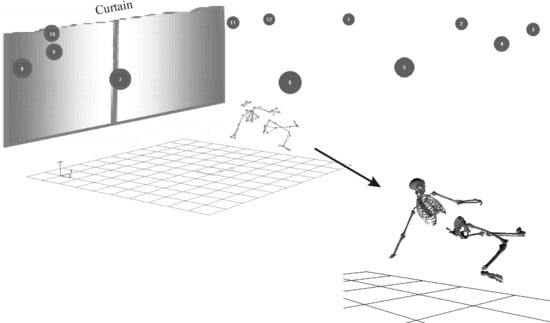Jumping Side Volley in Soccer—A Biomechanical Preliminary Study on the Flying Kick and Its Coaching Know-How for Practitioners
Abstract
:1. Introduction
2. Materials and Methods
2.1. How to Establish a Lab Test Condition for Mimicking Reality in an Application-Oriented Investigation?
2.2. Motion Capture and Biomechanical Modeling
3. Results
4. Discussion
- phase identification,
- trunk rotary control,
- hip flexibility,
- lower-limb control,
- upper-limb control, and
- coordination between upper- and lower-limbs.
5. Conclusions
Author Contributions
Funding
Conflicts of Interest
References
- FIFA. Average Number of Goals Scored per Game at the FIFA World Cup from 1930 to 2018. 2020. Available online: https://www.statista.com/statistics/269031/goals-scored-per-game-at-the-fifa-world-cup-since-1930/ (accessed on 26 January 2020).
- Hyballa, P. The art of flying. Success Soccer 2002, 5, 19–26. [Google Scholar]
- Reilly, T.; Williams, M. Science and Soccer, 2nd ed.; Routledge: London, UK, 2003. [Google Scholar]
- Shan, G. Biomechanical Know-how of Fascinating Soccer-kicking Skills–3D, Full-body Demystification of Maximal Instep Kick, Bicycle Kick & Side Volley. In Proceedings of the 8th International Scientific Conference on Kinesiology, Zagreb, Opatija, Croatia, 10–14 May 2017. [Google Scholar]
- Shan, G.; Zhang, X.; Wan, B.; Yu, D.; Wilde, B.; Visentin, P. Biomechanics of coaching maximal instep soccer kick for practitioners. Interdiscip. Sci. Rev. 2019, 44, 12–20. [Google Scholar] [CrossRef]
- YouTube. All 108 UEFA EURO 2016 Goals: Watch Every One. 2016. Available online: https://www.youtube.com/watch?v=a4Qvh6VIoSs (accessed on 26 January 2020).
- FIFA. FIFA Puskás Award. 2019. Available online: https://www.fifa.com/the-best-fifa-football-awards/puskas-award/ (accessed on 16 June 2019).
- UEFA. Top Ten Goals of UEFA EURO 2016 Revealed. 2016. Available online: https://www.uefa.com/uefaeuro-2020/news/0253-0d7e907eeaa5-b7d7554f6864-1000--top-ten-goals-of-uefa-euro-2016-revealed/ (accessed on 19 September 2018).
- Shan, G.; Visentin, P.; Zhang, X.; Hao, W.; Yu, D. Bicycle kick in soccer: Is the virtuosity systematically entrainable? Sci. Bull. 2015, 60, 819–821. [Google Scholar] [CrossRef] [Green Version]
- Smith, P.G.; Morrow, R.H.; Ross, D.A. Preliminary studies and pilot testing. In Field Trials of Health Interventions: A Toolbox, 3rd ed.; Oxford University Press: Oxford, UK, 2015. [Google Scholar]
- VICON. The Most Precise MoCap Ecosystem. 2020. Available online: https://www.vicon.com/applications/engineering/ (accessed on 26 January 2020).
- Smith, S.L. Application of high-speed videography in sports analysis. In Ultrahigh-and High-Speed Photography, Videography, and Photonics; International Society for Optics and Photonics: Bellingham, WA, USA, 1993. [Google Scholar]
- Chang, S.T.; Evans, J.; Crowe, S.; Zhang, X.; Shan, G. An innovative approach for Real Time Determination of Power and Reaction Time in a Martial Arts Quasi-Training Environment Using 3D Motion Capture and EMG Measurements. Arch. Budo 2011, 7, 185–196. [Google Scholar]
- Wan, B.; Gao, Y.; Wang, Y.; Zhang, X.; Li, H.; Shan, G. Hammer Throw: A Pilot Study for a Novel Digital-route for Diagnosing and Improving Its Throw Quality. Appl. Sci. 2020, 10, 1922. [Google Scholar] [CrossRef] [Green Version]
- Li, S.; Zhang, Z.; Wan, B.; Wilde, B.; Shan, G. The relevance of body positioning and its training effect on badminton smash. J. Sports Sci. 2017, 35, 310–316. [Google Scholar] [CrossRef] [PubMed]
- Liu, Y.; Kong, J.; Wang, X.; Shan, G. Biomechanical analysis of Yang’s spear turning-stab technique in Chinese martial arts. Phys. Act. Rev. 2020, 8, 16–22. [Google Scholar]
- Michalowski, T. Applications of MATLAB in Science and Engineering; BoD–Books on Demand: Norderstedt, Germany, 2011. [Google Scholar]
- Yu, D.; Yu, Y.; Wilde, B.; Shan, G. Biomechanical characteristics of the axe kick in Tae Kwon-Do. Arch. Budo 2012, 8, 213–218. [Google Scholar] [CrossRef]
- Visentin, P.; Staples, T.; Wasiak, E.B.; Shan, G. A pilot study on the efficacy of line-of-sight gestural compensation while conducting music. Percept. Mot. Skills 2010, 110, 647–653. [Google Scholar] [CrossRef] [PubMed]
- Shan, G.; Westerhoff, P. Full-body kinematic characteristics of the maximal instep soccer kick by male soccer players and parameters related to kick quality. Sports Biomech. 2005, 4, 59–72. [Google Scholar] [CrossRef] [PubMed]
- Shan, G. Influences of Gender and Experience on the Maximal Instep Soccer Kick. Eur. J. Sport Sci. 2009, 9, 107–114. [Google Scholar] [CrossRef]
- Shan, G.; Zhang, X. From 2D Leg Kinematics to 3D Full-body Biomechanics—The Past, Present and Future of Scientific Analysis of Maximal Instep Kick in Soccer. Sports Med. Arthrosc. Rehabil. Ther. Technol. 2011, 3, 23. [Google Scholar] [CrossRef] [PubMed] [Green Version]
- Shan, G.; Yuan, J.; Hao, W.; Gu, M.; Zhang, X. Regression equations for estimating the quality of maximal instep kick by males and females in soccer. Kinesiology 2012, 44, 139–147. [Google Scholar]
- Shan, G.; Daniels, D.; Wang, C.; Wutzke, C.; Lemire, G. Biomechanical analysis of maximal instep kick by female soccer players. J. Hum. Mov. Stud. 2005, 49, 149–168. [Google Scholar]
- Wan, B.; Shan, G. Biomechanical modeling as a practical tool for predicting injury risk related to repetitive muscle lengthening during learning and training of human complex motor skills. SpringerPlus 2016, 5, 441. [Google Scholar] [CrossRef] [PubMed] [Green Version]
- Shan, G.; Bohn, C. Anthropometrical data and coefficients of regression related to gender and race. Appl. Ergon. 2003, 34, 327–337. [Google Scholar] [CrossRef]
- Winter, D.A. Biomechanics and Motor Control of Human Movement; John Wiley & Sons: Hoboken, NJ, USA, 2009. [Google Scholar]
- Kearney, J.K.; Bhat, D.N.; Prasad, B.; Yuan, S.S. Efficient generation of whip-like throwing and striking motions. In Models and Techniques in Computer Animation; Magnenat-Thalmann, N., Thalmann, D., Eds.; Springer: Berlin, Germany, 1993; pp. 270–284. [Google Scholar]
- Zhang, X.; Shan, G. Where do golf driver swings go wrong?—Factors Influencing Driver Swing Consistency. Scand. J. Med. Sci. Sports 2014, 24, 749–757. [Google Scholar] [CrossRef] [PubMed]
- Zhang, Z.; Li, S.; Wan, B.; Visentin, P.; Jiang, Q.; Dyck, M.; Li, H.; Shan, G. The influence of X-factor (trunk rotation) and experience on the quality of the badminton forehand smash. J. Hum. Kinet. 2016, 53, 9–22. [Google Scholar] [CrossRef] [PubMed] [Green Version]
- Wąsik, J.A.; Ortenburger, D.O.; Góra, T.O.; Shan, G.O.; Mosler, D.; Wodarski, P.; Michnik, R.A. The influence of gender, dominant lower limb and type of target on the velocity of taekwon-do front kick. Acta Bioeng. Biomech. 2018, 20, 133–138. [Google Scholar] [PubMed]
- Ballreich, R.; Baumann, W. Grundlagen der Biomechanik des Sports (The Basics of Biomechanics in Sports); Enke Verlag: Stuttgart, Germany, 1996. [Google Scholar]
- Davids, K.; Araújo, D.; Hristovski, R.; Passos, P.; Chow, J.Y. Ecological dynamics and motor learning design in sport. In Skill Acquisition in Sport: Research, Theory and Practice, 2nd ed.; Hodges, N., Williams, M., Eds.; Routledge: London, UK, 2012; pp. 112–130. [Google Scholar]
- Santos, S.D.; Memmert, D.; Sampaio, J.; Leite, N. The spawns of creative behavior in team sports: A creativity developmental framework. Front. Psychol. 2016, 7, 1282. [Google Scholar] [CrossRef] [PubMed] [Green Version]
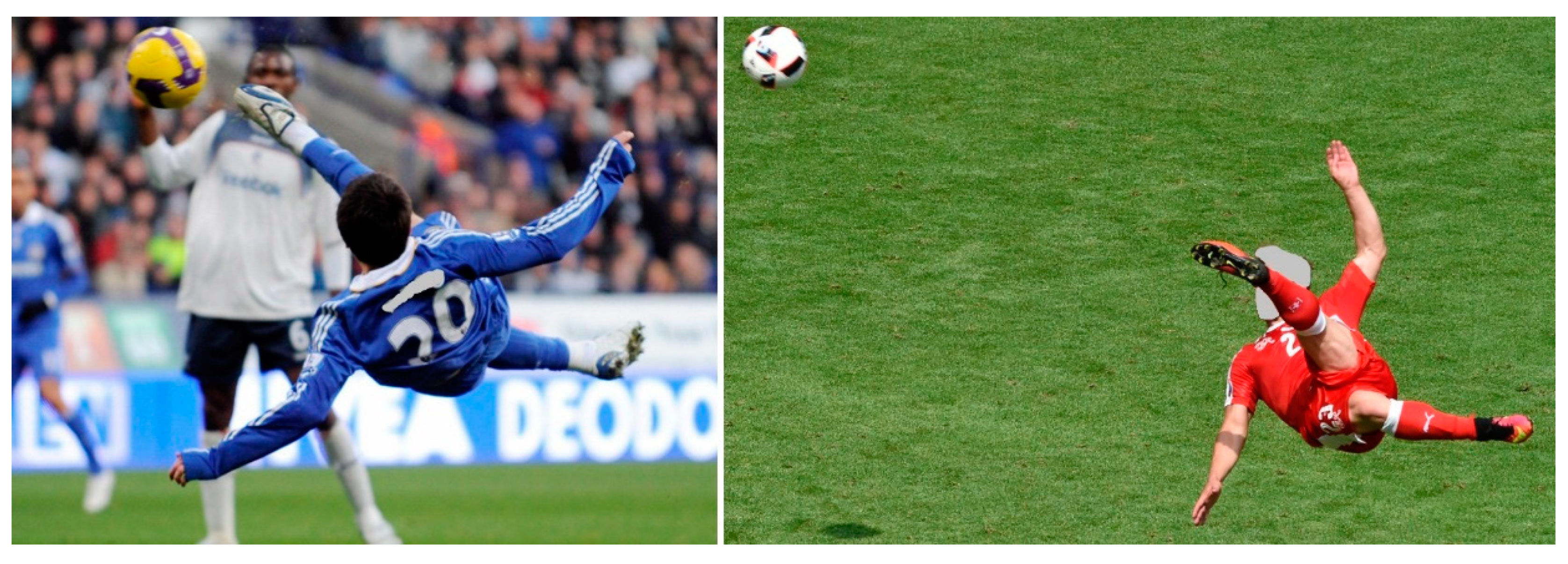
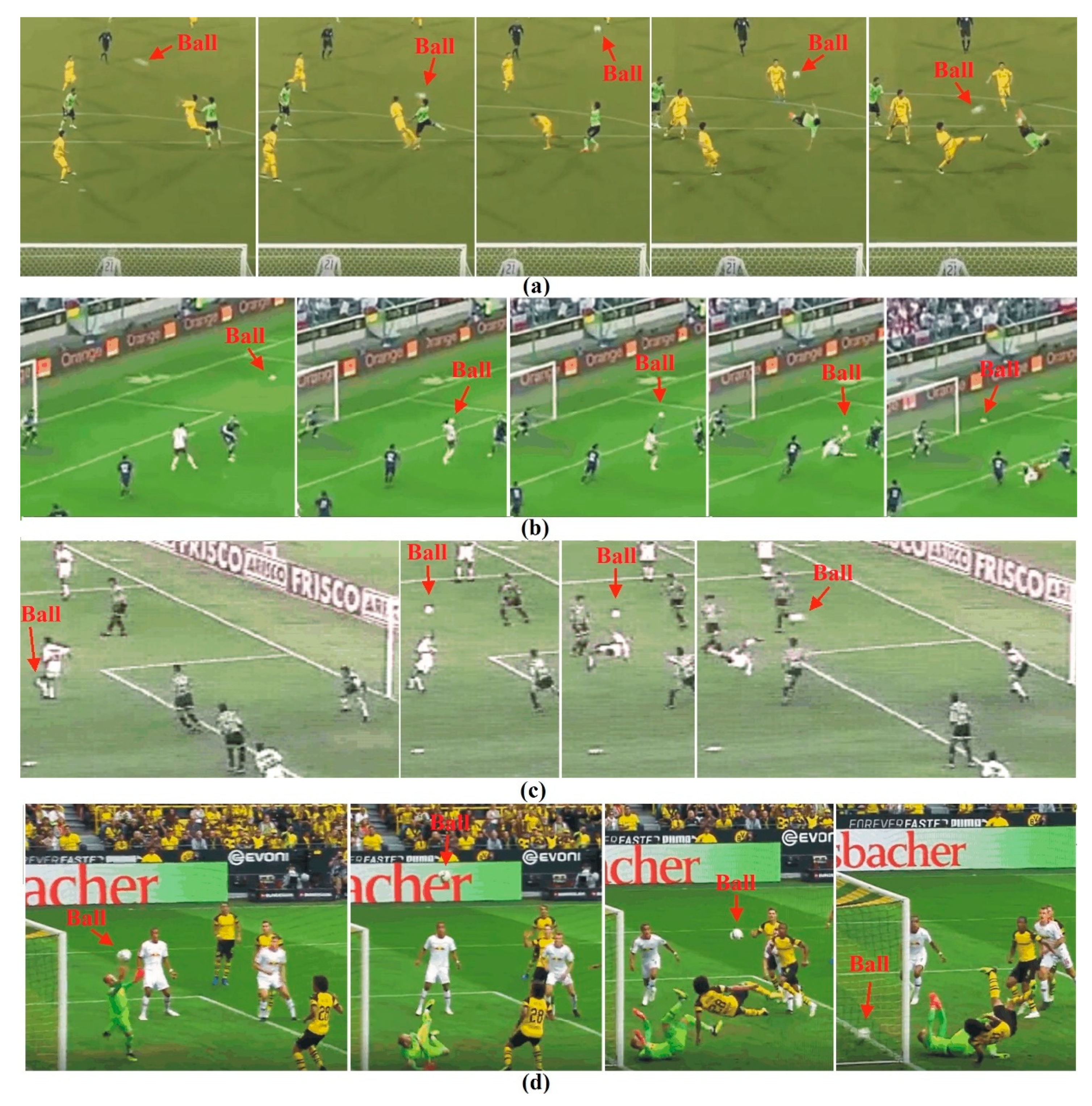
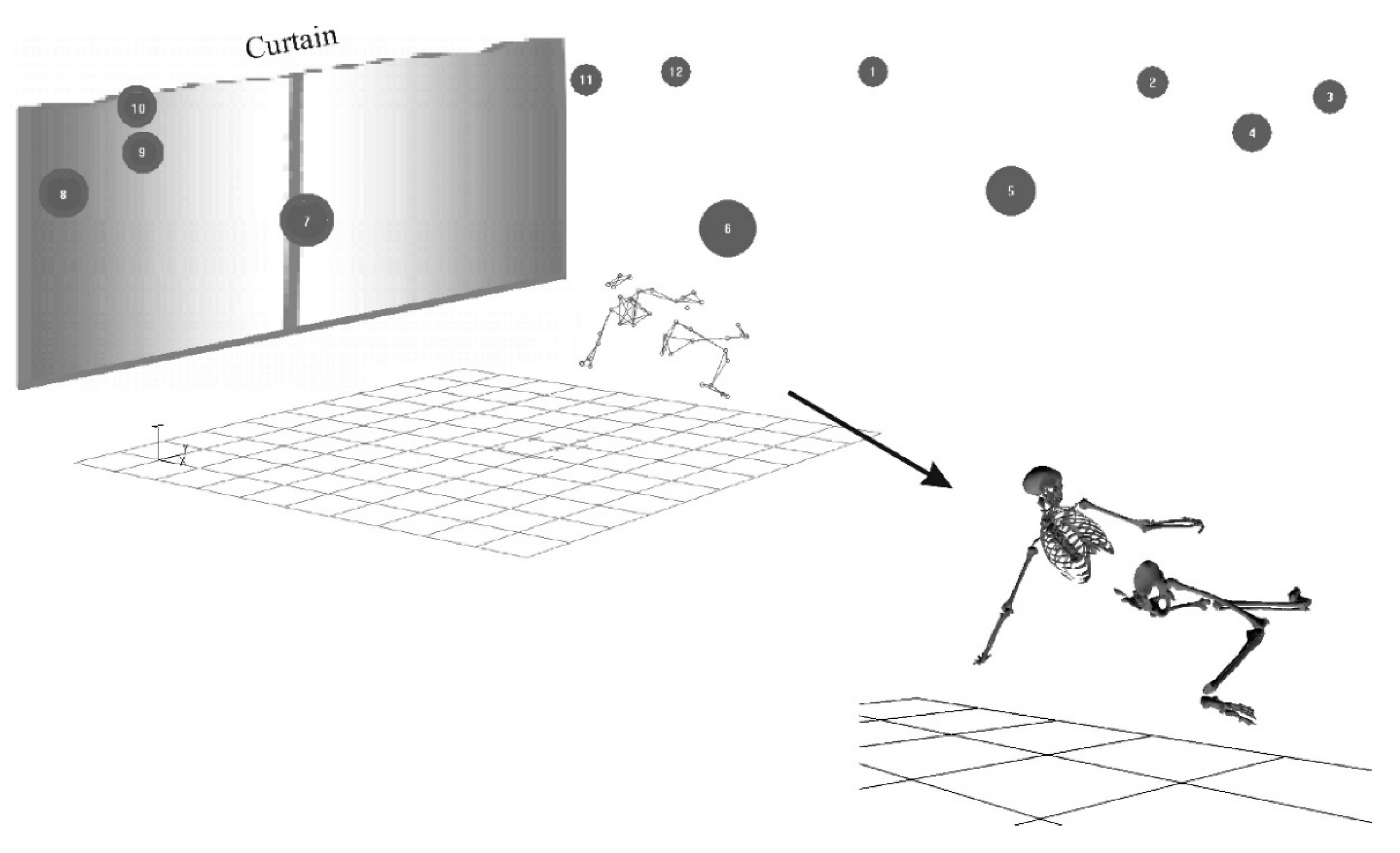

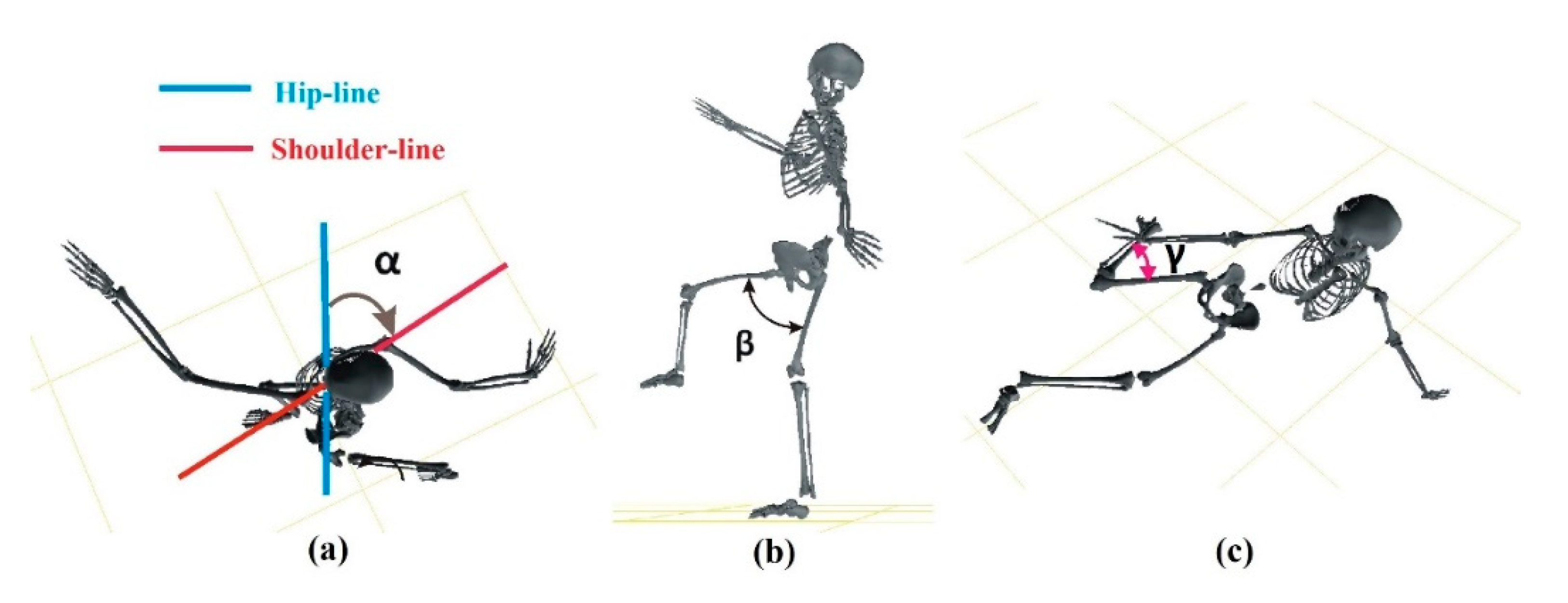
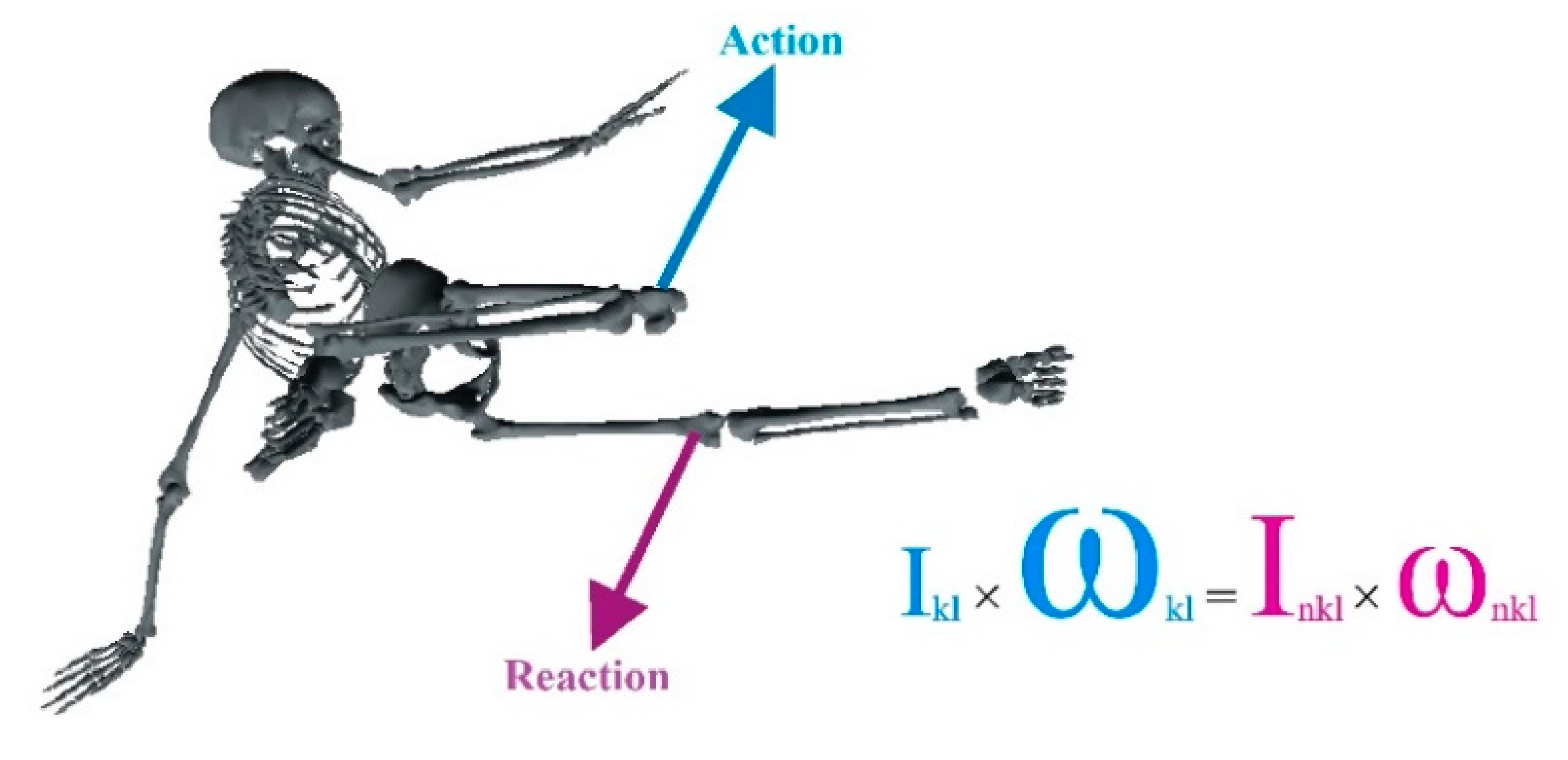
| Selected Parameters | Results | CI | CV | r | |
|---|---|---|---|---|---|
| ROM (°) | Trunk Twist (X-factor α) | 41.5 ± 5.1 | 40.5–42.6 | 0.12 | 0.86 |
| KS Hip (Flex/Ext) | 51.6 ± 5.2 | 50.5–52.7 | 0.10 | 0.71 | |
| KS Knee (Flex/Ext) | 56.9 ± 6.1 | 55.6–58.1 | 0.11 | 0.76 | |
| KS Ankle (Flex/Ext) | 11.6 ± 2.2 | 11.1–12.1 | 0.19 | 0.52 | |
| Angle (°) | Max Shoulder Abduction * | 83.7 ± 4.2 | 82.8–84.5 | 0.05 | 0.69 |
| Take-off Angle between Thighs (β) | 75.2 ± 13.0 | 72.5–77.9 | 0.17 | 0.82 | |
| Min KS Knee Angle | 84.1 ± 9.6 | 82.1–86.1 | 0.11 | −0.75 | |
| Coordination Timing (%) | Trunk → KS Hip | 83.2 ± 4.1 | 82.3–84.1 | 0.05 | 0.57 |
| KS Hip → KS Knee | 74.4 ± 15.4 | 71.2–77.6 | 0.21 | 0.89 | |
© 2020 by the authors. Licensee MDPI, Basel, Switzerland. This article is an open access article distributed under the terms and conditions of the Creative Commons Attribution (CC BY) license (http://creativecommons.org/licenses/by/4.0/).
Share and Cite
Zhang, X.; Shan, G.; Liu, F.; Yu, Y. Jumping Side Volley in Soccer—A Biomechanical Preliminary Study on the Flying Kick and Its Coaching Know-How for Practitioners. Appl. Sci. 2020, 10, 4785. https://doi.org/10.3390/app10144785
Zhang X, Shan G, Liu F, Yu Y. Jumping Side Volley in Soccer—A Biomechanical Preliminary Study on the Flying Kick and Its Coaching Know-How for Practitioners. Applied Sciences. 2020; 10(14):4785. https://doi.org/10.3390/app10144785
Chicago/Turabian StyleZhang, Xiang, Gongbing Shan, Feng Liu, and Yaguang Yu. 2020. "Jumping Side Volley in Soccer—A Biomechanical Preliminary Study on the Flying Kick and Its Coaching Know-How for Practitioners" Applied Sciences 10, no. 14: 4785. https://doi.org/10.3390/app10144785
APA StyleZhang, X., Shan, G., Liu, F., & Yu, Y. (2020). Jumping Side Volley in Soccer—A Biomechanical Preliminary Study on the Flying Kick and Its Coaching Know-How for Practitioners. Applied Sciences, 10(14), 4785. https://doi.org/10.3390/app10144785





